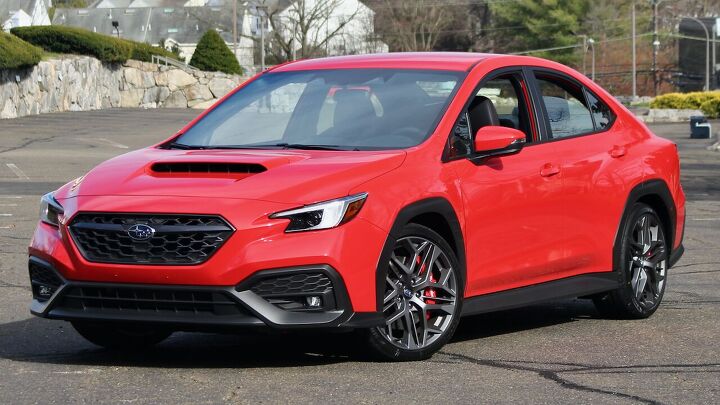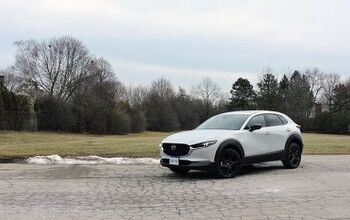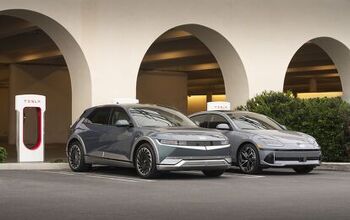2024 Subaru WRX TR Review: The More Things Change...

Like clockwork, every new Subaru WRX generation is met with criticism, only for Subaru to respond by adding subsequent trim(s) that supposedly make good on the newest vehicle’s disappointments. The introduction of the VB-gen WRX for the 2022 model year brought waves of hatred over the acres of cladding, negligible power increase, complaints that it wasn’t involving enough, and the demise of the beloved STI variant. The result is the WRX TR, a car in which Subaru claims to have tightened up the driving dynamics while maintaining the all-wheel-drive capability and fun-fused everyday drivability the sedan is known for.
It’s no secret that the VB generation Subaru WRX has had difficulty making friends since its launch, and I’m guilty of not feeling fondly towards the 2022 car. The way it looks isn’t doing it any favors, yet, as is usually the case with Subarus, time has somehow been kind towards the VB WRX and it looks less ungainly now than it did when it debuted. Maybe the shock has worn off, or maybe Subaru was onto something with all the cladding; overlanding and off-roadiness is all the rage in the design centers these days, after all. Or maybe it’s the TR trim’s gorgeous new 19” wheels and red Brembo brakes that are just tricking us into thinking it looks decent. We can’t deny it: Our Ignition Red test car wasn’t what we could call particularly good looking, but maybe the backdrop of bland-colored crossovers that blanket the Northeast has blinded us to what a sporty sedan painted in a bright color should evoke emotionally.
Visual appeal aside, performance still matters to buyers. Subaru has reworked the WRX for a new-for-2024 TR trim that marks the return of a long-forgotten WRX nameplate, one which was designated for a car supposedly geared more towards driving enthusiasts seeking out an all-wheel-drive sedan and less towards those who wandered into a Subaru dealership to buy an Outback and fell in love with the so-called performance family car that was sitting across the lot.
There’s notable improvements here, starting with the aforementioned all-new 19-inch wheels that are wrapped in 245/35 R19 Bridgestone Potenza S007 tires. The brakes are now Brembo 6-piston units up front and 2-piston out back, and the new stoppers come with larger pads and rotors and a larger master cylinder to go along with it. Subaru states the system helps resist fade while improving pedal feel and stopping power.
The revisions go further. Subaru updated the steering rack and revised the suspension with stiffer springs with improved dampers. Inside the TR are Recaro seats, a refined shifter, and the EyeSight safety suite, which for 2024 is available with the manual gearbox for the first time. The big-screen SUBARU STARLINK 11.6-inch Multimedia Plus is standard, and all TRs come sans-sunroof to lower the center of gravity (COG) and maximize headroom for helmets.
Powertrain
Unfortunately, that’s where the changes end, and that’s especially sad when it comes to the powertrain. The 2.4-liter four-cylinder Boxer engine is still turbocharged, it still makes 271 horsepower and 258 lb-ft of torque, the manual transmission still has six speeds (and the stick is the only trans the TR gets), and Subaru Symmetrical All-Wheel Drive is still standard (with Active Torque Vectoring, Subaru will proudly add). We need to discuss the engine further: Other than the bodywork, the drivetrain is the other major elephant in the VB WRX room. Versus the 2.0-liter turbocharged four-cylinder engine it replaced, the 2.4 brings only a marginal improvement in power (3 horsepower and 0 torque) without any improvements in efficiency.
Fuel Economy
About the disappointing gas mileage: The TR is rated for 19 MPG city and 26 MPG highway (as are all 2024 WRX models except the GT, which is rated at an even worse 18/25 city/highway), which is poor for a four-cylinder car in 2024, performance-focused or not. For reference, VW’s Golf R does roughly the same on gas with 40 more horsepower and 35 extra lb-ft of torque on tap, while the Honda Civic Type R does better with even more torque than the VW (with two fewer driven wheels). Even the Audi S3, which starts at only $3,000 more than the WRX GT, gets 23 mpg city and 32 mpg highway. We’ve always found WRXs’ gas mileage to be better in the real world than on paper (the TR averaged a computer-indicated 23 MPG in our care, and the 2017 WRX Limited that I owned once upon a time regularly pulled 30 MPG on the highway), but it’s still middling at best, all while requiring premium fuel to boot.
Then again, owners will be quick to point out that the WRX isn’t a car you purchase for fuel economy. This is the car you buy because you want it, not because you need it-- there’s a clear difference-- and there’s a wide parameter of tasks your sole vehicle needs to do. Fun, safety, people-hauling ability, and all-weather capability all sit about level on the WRX equalizer, and it takes stepping up to the TR trim, which starts at $41,655 USD, to get into one that raises the fun factor to something skewed the way more hardcore driving enthusiasts crave.
Handling and drivability
So, how does the TR drive? Truthfully, it drives exactly as you’d expect a WRX to drive. The funny thing about WRXs is that regardless of how much power or suspension trickery or modernized tires and/or interior bits you throw at one, it always comes back feeling like a slight variant of the same thing. This is good in some cases; take, for example, planting your foot mid-corner in second gear on a windy backroad. The WRX TR simply eats it up, no fuss, no drama, just digging in and pulling you out the other side, just as every other WRX has and will. Forget lane keep assist and the likes; The Symmetrical All-Wheel-Drive really is the driving aid of driving aids, an omnipresent helping hand of traction that perpetually makes driving the WRX easy, regardless of how hard you push it. Thankfully, it’s easy to notice the TR’s upgrades when not doing so.
Whatever Subaru did to retune the steering worked, albeit to an extent. Initial bite and turn-in is truly immediate, so much so that you have to recalibrate your brain a bit from what prior (and other modern) WRXs do when you start to turn the steering wheel off-center. It’s great for carving corners but almost acts to the vehicle’s detriment when on the highway, as the steering barely settles down at cruising speed and one tiny move of the wheel can mean it looks like you’re going for a lane change. As for steering feel, there may be marginally more feedback from the front end, but you’d have to drive another, non-TR version of the WRX back-to-back with one to notice. Still, the change in the steering is appreciated.
Like the steering feel, it’s hard to say if the changes in springs and damping have resulted in better cornering. The TR certainly gets around turns more flat (i.e., with less body roll) than did the last WRX that I tested (which was a 2022 Limited), but that takes away some of the rally theater that used to come with hucking a somewhat “loose” feeling WRX into and around a corner. The TR feels planted and grippy, though in a way that a modified entry-level sports sedan usually feels; that is to say, stiff. It’s sufferable over potholes and the likes, but barely so. The 19” wheels and thin tires don’t help the cause.
The other aspects of the WRX are fine, if not unremarkable. The six-speed manual transmission’s clutch is relatively effortless, and the shifter is remarkably easy to engage with, if not a bit numb when going through the gates. We do wish the Recaro seats had adjustable lumbar support; as-is, our ~1,500 mile loaner felt like it needed a few weeks of continuous driving to have the backrest broken in before the chairs would be properly suitable for assessment (this reminds us of the Recaros in the long-dead Ford Focus ST and Fiesta ST). Equally frustrating is the infotainment suite, partially for its general lack of intuitiveness and partially because many crucial controls are incorporated into a touchscreen that takes longer than desired to load. Want to adjust the HVAC fan speed upon startup? Better start counting sheep. At least wireless Apple CarPlay works seamlessly.
Back to that Boxer engine-sized elephant in the room. The thing about the WRX TR’s performance in the acceleration and speed departments is that there isn’t a huge sense of urgency. The 2.4-liter Boxer engine makes its peak horsepower at 5,600 RPM and the powerband falls on its face before getting there. This, plus a peak torque curve that Subaru says is delivered from 2,000-5,600 RPM, almost makes the WRX’s engine tedious to engage with. It feels like it’s dragging its own anchor, partially because of the 3,430 pound curb weight and partially because there is zero spectacle when going full throttle in the AWD WRX. Accordingly, the WRX TR will do 0-60 MPH in 5.5-6.0 seconds when driven rationally (i.e., not dumping the clutch from high RPM). Stat sheets don’t mean diddly squat in the real world, but the WRX feels its speed, if not slower. You want it to be the opposite version of this equation.
Meanwhile, much of the Subaru’s competition feels slightly unhinged, or at least less restrained, which means fun for many. Trying to best manage a car’s power is part of the excitement of driving, and while in some cases that means wrangling a front-wheel-drive car’s occasional unwillingness to maintain traction, this can at least enhance the experience of the car as a whole. In the WRX, the engine-drivetrain combination is simply a means to an end, and it must be understood that some of the lack of urgency is due to how safe and solid the WRX feels. This is an asset to those who want to daily drive these cars with their families in tow, but on the sporting side it makes for an underwhelming experience that’s desperate for an extra 50 horsepower to keep up with the lighter and more powerful cars that it would be cross-shopped with and, at the minimum, make the blasts between shifts something more thrilling.
Value, dollars, and sense
And so, we get to the WRX’s price, which is another issue (as it is with many things these days). The base 2024 WRX starts at a very palatable $32,735 USD, and the MSRP steps up to $34,635 for the Premium trim, $39,015 for the Limited, $41,655 for the TR, and $44,215 for the automatic-only and adaptive-suspension-bearing GT. The $40k realm is a tough one, as enthusiasts seeking tools for specific jobs can get a quite fun yet still very practical daily driver and supplement it with a weekend toy, but we recognize that’s not something everyone can swing or wants to deal with.
This leaves cars like the WRX TR square in the crosshairs of the target purchase for those seeking one car to cover practicality, fun, safety, and so on, all within a reasonable budget. But the WRX’s pricing has increased as of late, and sales have been faltering since 2016 (Editor Note: Subaru has clarified that it used to bucket together the WRX and STI sales numbers but that is no longer the case. Take this paragraph with a grain of salt). While market trends rarely correlate with the quality of a single vehicle, maybe it is indicative of something: After all this time, even with everything Subaru changed to make the TR trim more fun, better to drive, and more exciting than non-TR models, it’s still a WRX, and it still marches to the beat of its own drum-- for better and worse-- fully embodying “The more things change, the more they stay the same” as its own unofficial slogan.
Yet that tune has gone stale, and enthusiasts know other options exist to tickle their hoon-seeking fancy, and while we’re weary of being too harsh towards the WRX-- we recognize this might be the last iteration of the car as we know it, and we’ll likely look back on this one and think about how good we had it (as is usually done with Subaru WRX models)-- the sting of thinking the WRX TR could be even better than it is still hurts.
Don’t get us wrong, the 2024 Subaru WRX TR is a good and very competent car, it’s just not one as exciting or enjoyable to spend time in as it could be. It’s the safe option in a class of vehicles trying to dance the line between sensible and dangerous. We’re glad the WRX TR exists and hope to see it refined further before the VB bows out in a few years, and in a vacuum the TR is enjoyable enough, but we’d recommend taking a close look at the competition before plunking down the cash on the WRX TR.
Become an AutoGuide insider. Get the latest from the automotive world first by subscribing to our newsletter here.
2024 Subaru WRX TR FAQs
- Q. What's special about the 2024 Subaru WRX TR?
- A. The TR features an updated, stiffer suspension, revised steering, and grippier tires.
- Q. What does TR stand for on the WRX?
- A. Previously it stood for "Tuner Ready" as it was a very basic package ready for modifications. This new WRX TR is unofficially referred to as "Track Ready".
- Q. Will there be a 2025 Subaru WRX.
- A. Currently, all signs point ot yes, there will.

Ross hosts The Off the Road Again Podcast. He has been in the off-road world since he was a kid riding in the back of his dad’s YJ Wrangler. He works in marketing by day and in his free time contributes to Hooniverse, AutoGuide, and ATV.com, and in the past has contributed to UTV Driver, ATV Rider, and Everyday Driver. Ross drives a 2018 Lexus GX460 that is an ongoing build project featured on multiple websites and the podcast.
More by Ross Ballot









































Comments
Join the conversation
Overpriced and underpowered
Have you tried applying for a loan with Global Dominion?